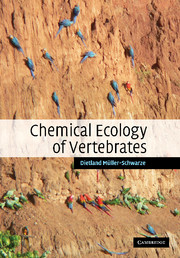Book contents
- Frontmatter
- Contents
- Preface
- Acknowledgements
- 1 The odorsphere: the environment for transmission of chemical signals
- 2 Properties of vertebrate semiochemicals
- 3 Odor production and release
- 4 Chemical cues in orientation and navigation
- 5 Chemoreception
- 6 Signaling pheromones I: discrimination and recognition
- 7 Signaling pheromones II: sex and alarm pheromones and evolutionary considerations
- 8 Intraspecific signals: priming pheromones
- 9 Development of intra- and interspecific chemical communication
- 10 Allomones I: chemical defense by animals
- 11 Allomones II: plant chemical defenses against herbivores
- 12 Kairomones and synomones
- 13 Practical applications of semiochemicals
- Glosssary
- References
- Index
7 - Signaling pheromones II: sex and alarm pheromones and evolutionary considerations
Published online by Cambridge University Press: 23 November 2009
- Frontmatter
- Contents
- Preface
- Acknowledgements
- 1 The odorsphere: the environment for transmission of chemical signals
- 2 Properties of vertebrate semiochemicals
- 3 Odor production and release
- 4 Chemical cues in orientation and navigation
- 5 Chemoreception
- 6 Signaling pheromones I: discrimination and recognition
- 7 Signaling pheromones II: sex and alarm pheromones and evolutionary considerations
- 8 Intraspecific signals: priming pheromones
- 9 Development of intra- and interspecific chemical communication
- 10 Allomones I: chemical defense by animals
- 11 Allomones II: plant chemical defenses against herbivores
- 12 Kairomones and synomones
- 13 Practical applications of semiochemicals
- Glosssary
- References
- Index
Summary
And all your courtly civet cats can vent, Perfume to you, to me is excrement.
pope, Epilogue to the Satires, Dial. 2, 1, 183Chapter 6 discussed signaling pheromones that allow discrimination, recognition, and broadcasting dominance and territorial status. This chapter explores the role of pheromones and other odors in reproduction, alarm, trail following, and in connection with food. Some evolutionary considerations conclude the discussion of signaling pheromones.
Sex pheromones: attracting and stimulating
Chemical cues are important to advertise one's sex and to attract the opposite sex as the first step in sexual behavior. Other functions of sexual signals are to signal current sexual status and to alter the behavior of the potential partner(s) via courtship or scent marking to facilitate mating. Typically, the odor of the opposite sex is attractive, at least in the breeding season. (Priming pheromones are covered separately in Chapter 8.)
Jawless fish (Agnatha)
Traditionally, French fishermen have used the male sex attractant of the sea lamprey, Petromyzon marinus. They bait a trap with an adult male and catch numerous females at night. Land-locked sea lamprey such as those in the Great Lakes of North America spawn in streams. Males arrive before the females and build nests. In laboratory choice experiments, ovulating females selected water from spermiating males and increased their searching behavior there. In a natural stream, females responded to male odors from as far as 65m. The active compound has been identified as a bile acid, specifically 7α, 12α, 24-trihydroxy- 5α-cholan-3-one 24-sulfate.
- Type
- Chapter
- Information
- Chemical Ecology of Vertebrates , pp. 171 - 202Publisher: Cambridge University PressPrint publication year: 2006



